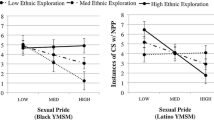Abstract
Gay and bisexual men (GBM) who participate in gay community subcultures have different profiles, including differing risk behaviors. We examined men’s participation in gay community subcultures, and its association with risk behavior. In a cross-sectional survey, 849 GBM provided information about men in their personal networks. We devised measures of their participation in five subcultural groupings and explored their associations with sexual behavior. We identified five subcultural groupings: sexually adventurous; bear tribes; alternative queer; party scene; and sexually conservative. Higher scores on the sexually adventurous measure was associated with being older, having more gay friends, being HIV-positive, and being more sexually active. It was also independently associated with unprotected anal intercourse with casual partners (AOR 1.82; 95 % CI 1.20–2.76; p = 0.005). HIV prevention strategies need to account for the different subcultural groupings in which GBM participate. Measures of engagement with gay subcultures are useful indicators of differential rates of risk behavior and modes of participation in gay community life. Men in more sexually adventurous subcultures are more likely to engage in sexual risk behavior.
Similar content being viewed by others
References
Seibt AC, Ross MW, Freeman A, et al. Relationship between safe sex and acculturation into the gay subculture. AIDS Care. 1995;7(S1):85–8.
Kippax SC, Connell RW, Dowsett GW, Crawford J. Sustaining safe sex: gay communities respond to AIDS. London: The Falmer Press; 1993.
Kippax S, Campbell D, Van de Ven P, et al. Cultures of sexual adventurism as markers of HIV seroconversion: a case control study in a cohort of Sydney gay men. AIDS Care. 1998;10:677–88.
Van de Ven P, Rawstorne P, Crawford J, Kippax S. Increasing proportions of Australian gay and homosexually active men engage in unprotected anal intercourse with regular and with casual partners. AIDS Care. 2001;14:335–41.
Holt M. Gay Men’s HIV Risk Reduction Practices: the Influence of Epistemic Communities in HIV Social and Behavioral Research. AIDS Educ Prev. 2014;26(3):214–23.
Halkitis PN, Parsons JT. Recreational drug use and HIV-risk sexual behavior among men frequenting gay social venues. J Gay Lesbian Soc Serv. 2003;2003(14):19–38.
Zablotska IB, Holt M, Prestage GP. Changes in gay men’s participation in gay community life: implications for HIV surveillance and research. AIDS Behav. 2012;16:669–75.
Di Franceisco W, Ostrow DG, Chmiel JS. Sexual adventurism, high-risk behavior, and human immunodeficiency virus-1 seroconversion among the Chicago MACS-CCS cohort, 1984 to 1992: a case-control study. Sex Transm Dis. 1996;23:453–60.
Halkitis PN, Green KA, Wilton L. Masculinity, body image, and sexual behavior in HIV-seropositive gay men: a two-phase formative behavioral investigation using the internet. Int J Men’s Health. 2004;3:27–42.
Zablotska I, Crawford J, Imrie J, et al. Increases in unprotected anal intercourse with serodiscordant casual partners among HIV negative gay men in Sydney. AIDS Behav. 2009;13:638–44.
Prestage GP, Hudson J, Down I, et al. Gay men who engage in group sex are at increased risk of HIV infection and onward transmission. AIDS Behav. 2009;13:724–30.
Commonwealth of Australia. Seventh national HIV strategy 2014–2017. Canberra: Department of Health; 2014.
NSW Government. NSW HIV strategy 2012–2015—a new rra. North Sydney: NSW Ministry of Health; 2012.
Prestage GP, Fengyi J, Grulich AE, De Wit J, Zablotska I. Gay men are less likely to use condoms with casual partners they know well. AIDS Behav. 2012;16(3):664–8. doi:10.1007/s10461-011-952-8.
Rouwenhorst E, Mallitt K, Prestage GP. Gay men’s use of condoms with casual partners depends on the extent of their prior acquaintance. AIDS Behav. 2012;16(6):1589–96.
Zablotska I, Grulich AE, De Witt J, Prestage GP. Casual sexual encounters among gay men: trust and unprotected anal intercourse. AIDS Behav. 2012;15(3):607–12.
Smith AM, Grierson J, Wain D, Pitts M, Pattison P. Interpersonal and social network influences on gay men’s communication about unprotected sex. Int J STD AIDS. 2006;17(4):267–70.
Morris M, Kretzschmar M. Concurrent partnerships and the spread of HIV. AIDS. 1997;11(5):641–8.
Bandura A. Social foundations of thought and action: a social cognitive theory. New Jersey: Prentice Hall; 1986.
Yang M, Prestage G, Maycock B, et al. The acceptability of different HIV testing approaches: cross-sectional study among GMSM in Australia. Sex Transm Infect. 2014;90:592–5.
Prestage G, Jin F, Bavinton B, Scott SA, Hurley M. Do differences in age between sexual partners affect sexual risk behaviour among Australian gay and bisexual men? Sex Transm Infect. 2013;89:653–8.
Prestage G, Jin F, Bavinton B, Hurley M. Sex workers and their clients among Australian gay and bisexual men. AIDS Behav. 2014;18(7):1293–301.
Hurley M, Prestage GP. Intensive sex partying amongst gay men in Sydney. Cult Health Sex. 2009;11:597–610.
Bollen J, McInnes D. Time, relations and learning in gay men’s experiences of adventurous sex. Soc Semiot. 2004;14:21–36.
Brown G, Maycock B. Different spaces, same faces: perth gay men’s experiences of sexuality, risk and HIV. Cult Health Sex. 2005;7(1):59–72.
Acknowledgments
This study was funded by the National Health and Medical Research Council of Australia. The Kirby Institute is affiliated with the Faculty of Medicine, University of New South Wales. The Centre for Social Research in Health is affiliated with the Faculty of Arts, University of New South Wales. The Australian Research Centre in Sex Health and Society (ARCSHS) is affiliated with the Faculty of Health Sciences, La Trobe University. The Kirby Institute, CSRH, and ARCSHS receive funding from the Commonwealth of Australia Department of Health and Ageing.
Conflict of interest
None.
Author information
Authors and Affiliations
Corresponding author
Rights and permissions
About this article
Cite this article
Prestage, G., Brown, G., De Wit, J. et al. Understanding Gay Community Subcultures: Implications for HIV Prevention. AIDS Behav 19, 2224–2233 (2015). https://doi.org/10.1007/s10461-015-1027-9
Published:
Issue Date:
DOI: https://doi.org/10.1007/s10461-015-1027-9



